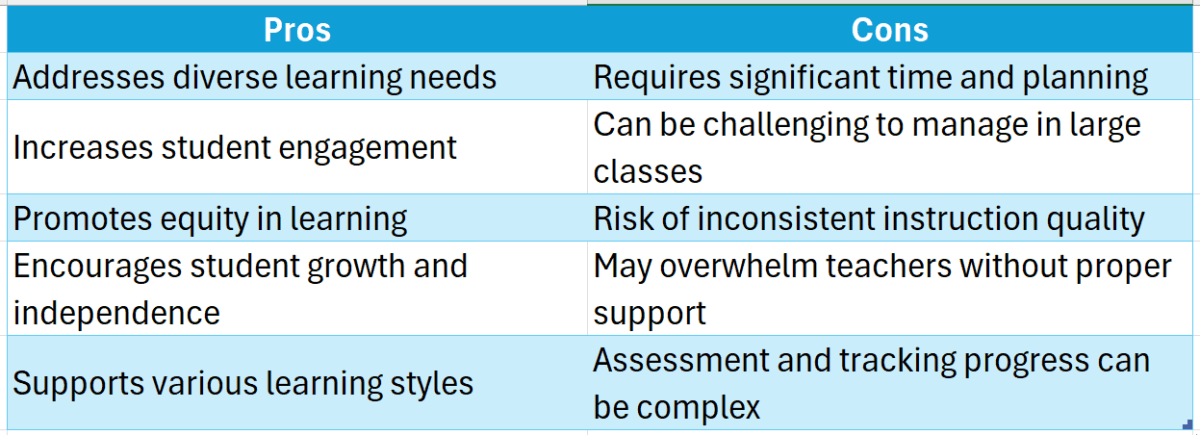
Understanding how to adapt lessons for all learners is crucial in today’s diverse classrooms. Differentiated teaching is a method that allows educators to tailor their instruction to meet the varied needs of students. This approach not only fosters a more inclusive environment but also enhances student engagement and learning outcomes.
What is Differentiated Teaching?
Differentiated teaching means adjusting lessons to accommodate different learning styles and abilities. Here are some key aspects:
- Flexible Grouping: Students can work in groups based on their skill levels or interests.
- Varied Resources: Using different materials, like videos or hands-on activities, helps reach all learners.
- Ongoing Assessment: Regular check-ins allow teachers to modify lessons as needed.
Benefits of Differentiated Teaching
Implementing differentiated teaching can lead to significant benefits:
- Increased Engagement: Students feel more connected when lessons relate to their interests.
- Improved Literacy Teaching: Tailoring reading and writing activities helps all students progress.
- Community-Based Instruction: Connecting lessons to real-world experiences enhances understanding and retention.
By embracing differentiated teaching, educators can create a vibrant learning atmosphere where every student has the opportunity to succeed.
Study smarter, not harder—Enroll online today!
Why Differentiated Teaching is Essential for Diverse Classrooms

In today’s diverse classrooms, every student comes with unique strengths and challenges. This is where differentiated teaching shines. By adapting lessons to meet various learning needs, teachers can ensure that all students, regardless of their background or abilities, have the opportunity to succeed. This approach not only boosts confidence but also fosters a love for learning.
Understanding Individual Needs
Every learner is different. Some may excel in literacy teaching, while others might struggle. By recognizing these differences, educators can tailor their instruction. This could mean providing extra support for those who need it or offering advanced materials for quicker learners.
Benefits of Differentiated Teaching
- Engagement: Students are more likely to participate when lessons resonate with their interests.
- Improved Outcomes: Personalized instruction can lead to better academic performance.
- Community-Based Instruction: Incorporating real-world experiences helps students connect learning to their lives, making lessons more relevant and impactful.
Ultimately, differentiated teaching is not just a strategy; it’s a commitment to equity in education. By embracing this approach, teachers can create a classroom environment where every student feels valued and empowered to learn. This is essential for building a strong, inclusive community of learners.
Key Principles of Differentiated Teaching: A Framework for Success
Differentiated teaching is crucial in modern classrooms, ensuring that every student, regardless of their learning style or ability, can engage with the material. By adapting lessons, teachers create an inclusive environment where all learners can thrive, boosting confidence and enhancing academic performance.
Understand Your Learners
To implement differentiated teaching effectively, start by understanding your students. Assess their strengths, weaknesses, and interests to tailor lessons that resonate with each learner, making education more relevant and engaging.
Flexible Grouping
Utilize flexible grouping strategies by mixing students based on their needs or interests. For example, during literacy teaching, some students might work in pairs while others tackle tasks independently. This fosters collaboration and encourages peer learning, enhancing the educational experience.
Varied Instructional Strategies
Incorporate diverse instructional strategies to cater to different learning styles. Use visual aids, hands-on activities, and technology to make lessons engaging. In community-based instruction, students can explore real-world applications, making learning more meaningful.
Ongoing Assessment
Regularly assess student progress using formative assessments like quizzes and discussions. This feedback allows you to adjust lessons and provide targeted support, ensuring every student stays on track for success.
Foster a Supportive Environment
Create a classroom atmosphere that encourages risk-taking and celebrates diversity. When students feel safe to express themselves, they engage more in learning, enhancing motivation and fostering a sense of belonging.
How to Assess Student Needs for Effective Differentiation
Understanding how to assess student needs is crucial for effective differentiated teaching. Every learner is unique, and recognizing their individual strengths and challenges helps educators tailor lessons that resonate. This approach not only fosters engagement but also promotes a deeper understanding of the material.
Identifying Student Needs
To effectively differentiate instruction, consider these strategies:
- Observation: Watch how students interact with lessons. Are they engaged or confused?
- Surveys: Ask students about their interests and learning preferences. This feedback can guide your lesson planning.
- Community-based instruction: Integrate real-world experiences that connect with students’ lives, making learning more relevant and exciting.
Implementing Differentiation
Once you understand your students’ needs, you can adapt your literacy teaching methods. Here are some tips:
- Flexible Grouping: Change groups based on the activity or topic to encourage collaboration.
- Varied Resources: Provide different materials that cater to diverse reading levels and learning styles.
- Ongoing Assessment: Regularly check in on student progress to adjust your teaching strategies as needed.
Strategies for Implementing Differentiated Teaching in Your Lessons
Differentiated teaching is essential in today’s classrooms because every student learns differently. By adapting lessons for all learners, teachers can ensure that everyone, regardless of their abilities, can engage with the material. This approach not only boosts confidence but also fosters a love for learning.
Know Your Students
Understanding your students’ strengths and weaknesses is the first step. Use assessments and observations to identify their learning styles. This knowledge helps you tailor your lessons effectively, ensuring that each student feels included and valued.
Use Community-Based Instruction
Incorporating community-based instruction can make learning more relevant. For example, take students on field trips or invite local experts to share their knowledge. This real-world connection can enhance literacy teaching by making lessons more engaging and relatable.
Offer Choices
Give students options in how they learn and demonstrate their understanding. For instance, allow them to choose between writing a report, creating a presentation, or developing a project. This flexibility encourages ownership of their learning and caters to diverse interests and abilities.
Study smarter, not harder—Enroll online today!
What Role Does Technology Play in Differentiated Teaching?
Differentiated teaching is all about meeting the diverse needs of students. In today’s classrooms, learners come with different backgrounds, abilities, and interests. So, how can we adapt lessons to ensure everyone thrives? One powerful ally in this journey is technology. It opens doors to personalized learning experiences that cater to individual needs.
Technology plays a crucial role in differentiated teaching by providing tools that enhance learning. Here are some ways it helps:
- Personalized Learning: With online platforms, students can learn at their own pace. They can revisit lessons or dive deeper into topics that interest them.
- Community-Based Instruction: Technology connects students with real-world resources and communities, enriching their learning experience. For example, virtual field trips can bring history to life!
- Literacy Teaching: Digital tools like e-books and interactive apps can support literacy teaching by offering engaging ways to practice reading and writing skills.
These resources can adapt to each student’s level, making learning more effective. In summary, technology is a game-changer in differentiated teaching. It empowers teachers to create tailored lessons that engage all learners, ensuring no one gets left behind.
Real-Life Examples of Differentiated Teaching in Action
Differentiated teaching is crucial because it ensures that every student, regardless of their learning style or ability, can thrive in the classroom. By adapting lessons to meet diverse needs, teachers can create an inclusive environment where all learners feel valued and engaged. Let’s explore some real-life examples of how this approach works in action.
Community-Based Instruction
One effective method of differentiated teaching is community-based instruction. For instance, a teacher might take students on a field trip to a local museum. Here, students can explore history through hands-on activities. While some students might focus on reading exhibits, others can engage in interactive workshops. This way, everyone learns in a way that suits them best!
Literacy Teaching Strategies
Another example is in literacy teaching. A teacher could offer various reading materials based on students’ interests and reading levels. For example, some students might read graphic novels, while others tackle chapter books. Additionally, group discussions can be tailored, allowing students to share insights at their comfort level. This not only boosts confidence but also enhances comprehension for all learners.
How Scholarship.Education Can Support Your Differentiated Teaching Journey
Differentiated teaching is essential in today’s diverse classrooms. It ensures that every student, regardless of their learning style or ability, can engage with the material. By adapting lessons, teachers can create an inclusive environment where all learners thrive. So, how can Scholarship.Education support your differentiated teaching journey?
Tailored Resources for Every Learner
At Scholarship.Education, we provide a variety of resources designed for differentiated teaching. You can find materials that cater to different learning styles, from visual aids to hands-on activities. This variety helps in making literacy teaching more effective and engaging for all students.
Community-Based Instruction
We also emphasize community-based instruction. This approach connects classroom learning to real-world experiences. By integrating local resources, students can see the relevance of their lessons, making learning more meaningful and exciting.
Easy-to-Use Tools
- Interactive Lessons: Our platform offers interactive lessons that can be easily modified.
- Assessment Tools: Use our assessment tools to gauge student understanding and adjust your teaching accordingly.
- Supportive Community: Join a community of educators sharing tips and strategies for successful differentiated teaching.
With these resources, Scholarship.Education can help you create a classroom where every student feels valued and capable of success!
Study smarter, not harder—Enroll online today!
FAQs
1. What is differentiated teaching?
Differentiated teaching is an instructional approach where teachers tailor their lessons to meet the diverse needs, skills, and interests of their students.
2. Why is differentiated teaching important?
It helps ensure that all students, regardless of ability level, stay engaged, challenged, and supported in their learning.
3. How do teachers differentiate instruction?
Teachers can adjust the content, process, product, or learning environment based on student readiness, interests, and learning profiles.
4. Is differentiated teaching only for students with special needs?
No, differentiated teaching benefits all students, including those who are advanced, struggling, or have different learning styles.
5. What are some examples of differentiated teaching?
Examples include offering varied reading materials, giving students project choices, using flexible groupings, and adjusting assignments by difficulty.
6. Does differentiated instruction require more planning?
Yes, it often requires extra planning, but it leads to more effective learning outcomes and greater student engagement.





